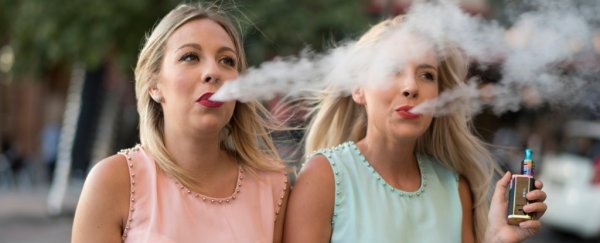Emissions from e-cigarettes are not harmless and calling them vapour is purposefully misleading, scientists argue.
While the puffs from e-cigs aren't exactly smoke, the term 'vapour' often brings to mind an innocuous cloud of water.
As such, public health experts argue 'aerosol' is a more accurate description, as e-cigarette clouds have been shown to contain harmful chemicals that may hang in the air and settle on nearby surfaces.
The change in name might sound pedantic, but new research suggests it has a real impact on public policy and how individuals assess their risk of exposure from tobacco products.
Comparing three terms for e-cig emissions among 791 college students, researchers found the word "vapour" was linked to a lower sense of risk from secondhand exposure.
On the other hand, students who were asked questions using the words "chemicals" or "aerosols" were twice as likely to describe emissions as "harmful" or "very harmful".
These individuals were also more likely to support a 100 percent tobacco-free campus policy.
"Smoke-free and tobacco-free campus environments are always a common-sense public health measure, and are especially so at this time, given the strong link between tobacco use and COVID-19 transmission among young people," says public health scientist Matthew Rossheim from George Mason University.
"Colleges and universities are encouraged to urgently adopt tobacco-free campus policies to help prevent the spread of coronavirus."
Since 2012, the number of smoke-free universities in the United States has more than tripled, and yet 1 in 6 of such campuses still do not include e-cigarettes in that equation.
That's problematic, researchers say, because while normal cigarette smoke may contain more toxicants, recent evidence suggests e-cigarette clouds can still expose bystanders to nicotine, heavy metals, ultra fine particulates, volatile organic compounds, and other toxicants.
Today, e-cigarettes are the most prevalent form of tobacco use among young people, in large part because they've been marketed as a safe alternative to regular cigarettes.
In a 2017 report from the US Centres for Disease Control and Prevention (CDC), more than half of middle and high school students said they'd been exposed to secondhand tobacco product emissions in indoor or outdoor public places.
The US Surgeon general has called the increase of e-cigarette use among young people a public health "epidemic", and scientists are worried it could reverse decades of hard work on tobacco use.
Terms like 'vapour', which tend to downplay the risk of secondhand exposure, may very well contribute to such widespread use.
With recent evidence showing vapers are at higher risk of COVID-19, public health experts say it's important we take action to minimise the risk of e-cigarettes, especially on college campuses re-opening amidst the pandemic.
Keeping up with a changing landscape of names - including "e-cigarettes", "e-cigs", "cigalikes", "e-hookahs", "mods", "vape pens", "vapes" and "tank systems" - is already a challenge, but we need to recognise the power such framing can have and avoid using inaccurate terms that perpetuate misconceptions, researchers argue.
In a 2016 study on the perceptions of e-cigarette terminology, for instance, e-cigarette users did not see themselves as "smokers".
"Yeah, it looks like smoke but you got to correct them if it's in like a public environment, just so that it's clarified that it's vapour," said one young adult.
Another recent study found many see bystander safety as a benefit of e-cigarette smoking, while newer generations of e-cigarettes are commonly called "vapes" among young people.
"Tobacco control efforts should also be directed to passing new legislation to regulate the marketing practices of the e-cigarette industry so that, among other issues, they do not frame communication to downplay nor deceive the public with regard to the harmfulness of their products," the authors conclude.
The study was published in the Journal of American College Health.
